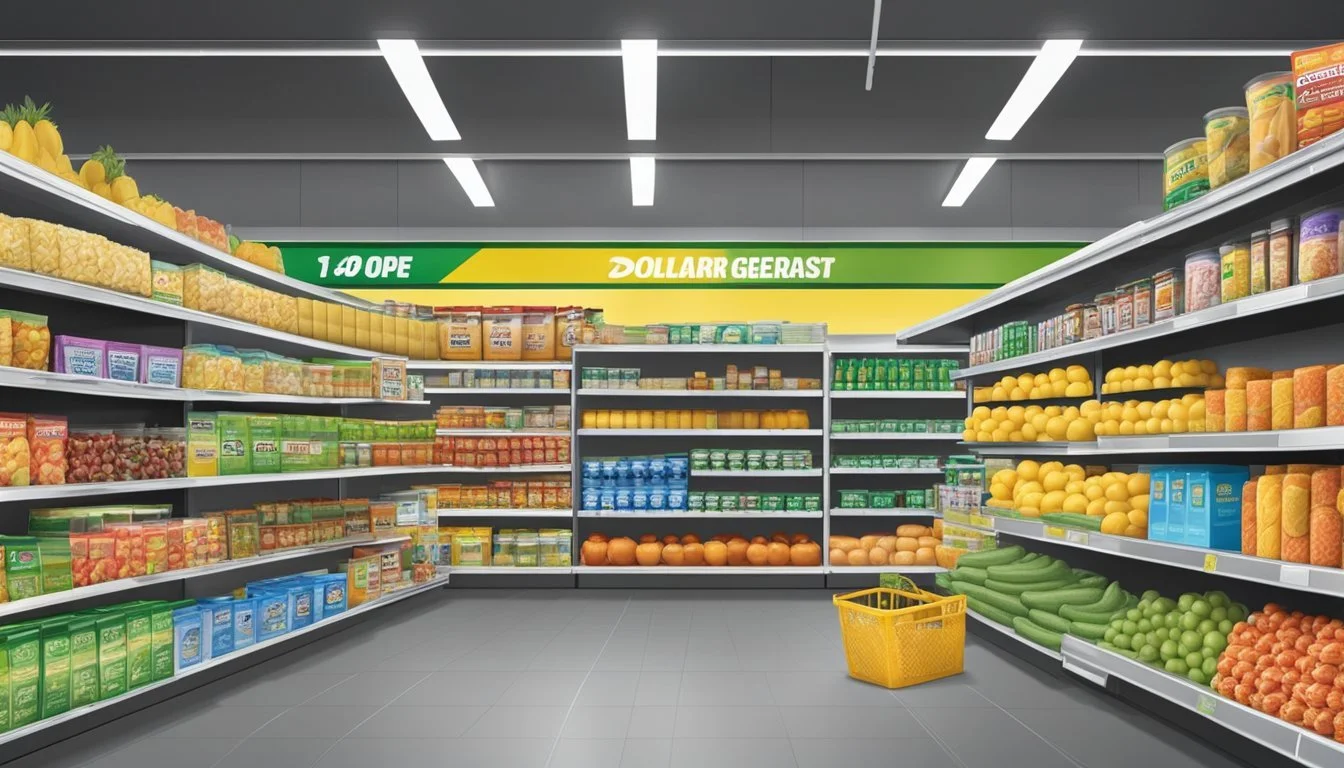Is Dollar General Cheaper Than Grocery Outlet?
A Price Comparison of Budget Retailers
When comparing grocery prices, shoppers often wonder if Dollar General offers better deals than Grocery Outlet. Both stores are known for their discounted offerings, but their pricing strategies and product selection differ.
Dollar General generally has lower prices on many staple items compared to Grocery Outlet, but the latter often provides deeper discounts on brand-name products. Dollar General focuses on everyday low prices across a wide range of household essentials and groceries. Grocery Outlet, on the other hand, specializes in selling overstock and closeout merchandise at significant markdowns.
The choice between these two retailers ultimately depends on individual shopping needs and preferences. Dollar General's consistent pricing and broader selection of non-food items may appeal to some, while Grocery Outlet's rotating inventory of deeply discounted brand-name products might attract others seeking specific deals.
Understanding the Business Models
Dollar General and Grocery Outlet employ distinct strategies to offer low prices to consumers. These approaches shape their operations, product selection, and customer experiences.
Dollar Store Concepts
Dollar General operates on an Everyday Low Price (EDLP) model. This strategy focuses on consistently offering products at affordable prices rather than relying on frequent sales or promotions. Dollar General stocks a wide range of merchandise, including consumables, home products, and apparel.
The company targets small markets with limited shopping options and larger, more competitive areas. By maintaining a lean operational structure and efficient supply chain, Dollar General keeps costs down. This allows them to price items competitively while still maintaining profitability.
Dollar General's stores are typically smaller than traditional supermarkets, reducing overhead costs. They often carry their own store brands, which offer lower prices compared to national brands.
Grocery Outlet Approach
Grocery Outlet uses a unique "opportunistic sourcing" model. This approach involves purchasing surplus inventory, discontinued items, and overstock products from manufacturers and distributors at discounted rates.
By acquiring these goods at lower costs, Grocery Outlet can offer significant savings to customers. Prices are often 40% to 70% below traditional grocery stores. This model also supports sustainability by reducing food waste.
Grocery Outlet's inventory changes frequently based on available deals. This creates a "treasure hunt" shopping experience for customers. The company focuses on name-brand products, offering familiar items at discounted prices.
Each Grocery Outlet store is independently owned and operated. This allows for local customization of product selection and community engagement.
Price Analysis
Dollar General and Grocery Outlet both claim to offer low prices, but their pricing strategies differ. A closer look reveals important distinctions in how these retailers approach discounts and maintain competitive pricing.
Comparing Average Prices
Dollar General's average prices tend to be higher than Grocery Outlet's across most product categories. A basket of common household items at Dollar General typically costs 5-10% more than at Grocery Outlet. However, Dollar General often has lower prices on name-brand packaged goods and personal care items.
Grocery Outlet shines in fresh produce and dairy, with prices up to 30% below Dollar General. Their "opportunistic buying" model allows them to offer steep discounts on overstocked or seasonal items. This can result in savings of 40-70% compared to conventional supermarkets.
Discount Patterns Across Chains
Dollar General relies on everyday low pricing and small package sizes to create the perception of value. They offer fewer deep discounts but maintain consistent prices. Their "$1 aisle" features bargain items, though selection varies by store.
Grocery Outlet's prices fluctuate more due to their liquidation-based inventory model. They run frequent sales on perishables nearing expiration dates. This approach leads to bigger potential savings but less predictable availability of specific products.
Both chains undercut major retailers like Walmart and Target by 10-20% on average. However, bulk retailers like Costco and discount grocers like Aldi often beat both on per-unit pricing for larger quantities.
Product Assortments
Dollar General and Grocery Outlet offer distinct product selections, each tailored to their business models and target customers. Their assortments differ in availability, quality, and brand offerings.
Availability of Goods
Dollar General focuses on providing a limited assortment of everyday essentials. The store carries approximately 10,000-12,000 SKUs, primarily consisting of household items, packaged foods, and basic groceries. Fresh produce is available in select locations, but the selection is often minimal.
Grocery Outlet, in contrast, offers a wider range of products, including a more extensive selection of fresh produce, meat, and organic options. The store's inventory is constantly changing, as they source overstock and closeout items from various suppliers.
Quality and Brand Diversions
Dollar General primarily stocks generic staples and store brands, with a limited selection of national brands. The quality of products is generally consistent but may not match that of higher-end retailers.
Grocery Outlet carries a mix of national brands, private labels, and lesser-known brands. The store often features high-quality products at discounted prices due to its opportunistic buying strategy. Customers can find organic produce and specialty items alongside budget-friendly options.
Both stores prioritize affordability, but Grocery Outlet tends to offer a broader range of quality levels within its product assortment.
Consumer Shopping Experience
Dollar General and Grocery Outlet offer distinct shopping experiences for bargain-seeking customers. Their approaches to store layout and checkout processes shape how consumers interact with these discount retailers.
Store Layout and Design
Dollar General stores typically feature a compact, no-frills layout. Aisles are narrow and packed with a variety of products, from household essentials to basic groceries. The design prioritizes efficiency over aesthetics, allowing customers to quickly locate everyday items.
Grocery Outlet, on the other hand, provides a more traditional grocery store experience. Its layout resembles that of conventional supermarkets, with wider aisles and dedicated sections for produce, dairy, and frozen foods. The store's design emphasizes its focus on discounted grocery items and brand-name products at reduced prices.
Both retailers use simple signage to guide shoppers through departments. Dollar General often employs a color-coded system, while Grocery Outlet relies on clear category labels.
Checkout Efficiency
Dollar General aims for quick transactions. Stores typically have limited checkout lanes, often with self-checkout options available. This approach suits customers making small, frequent purchases.
Grocery Outlet generally offers more staffed checkout lanes to accommodate larger shopping trips. The chain focuses on personal service, with cashiers trained to handle varied product types and quantities.
Both stores implement strategies to minimize wait times. Dollar General's compact size allows for swift movement through the store, while Grocery Outlet's broader layout may require more time for a complete shopping trip.
Cost-Saving Opportunities
Both Dollar General and Grocery Outlet offer various ways for shoppers to stretch their budgets. These retailers employ different strategies to provide customers with savings on everyday essentials and groceries.
Loyalty Programs and Discounts
Dollar General's DG Digital Coupons program allows customers to save money on specific items. Shoppers can clip digital coupons on the store's app or website before shopping. These coupons automatically apply at checkout when using the associated phone number.
Grocery Outlet doesn't offer a traditional loyalty program. However, they provide "WOW deals" - deeply discounted items that change regularly. These deals often include name-brand products at significant markdowns.
Both stores frequently run sales on various products. Dollar General typically advertises these in weekly ads, while Grocery Outlet's deals are often in-store surprises.
Special Deals and Coupons
Dollar General offers "DG GO!" - a mobile app that lets customers scan items as they shop. This app provides exclusive coupons and tracks spending in real-time. The store also features "DG Pickup" for online orders with in-store pickup, sometimes offering additional savings.
Grocery Outlet focuses on providing bargains through its unique business model. They buy excess inventory from manufacturers at discounted rates and pass savings to customers. This approach results in ever-changing inventory and prices that can be up to 70% lower than traditional supermarkets.
Both retailers use loss leaders - products priced at or below cost to attract customers. These deals are often featured prominently in store advertisements and can lead to significant savings for savvy shoppers.
Consumer Behavior and Trends
Shopping habits have shifted dramatically in response to economic pressures. Consumers are seeking ways to stretch their budgets and maximize value when purchasing groceries and household items.
Impact of Inflation on Shopping Habits
Inflation has significantly altered how families approach their grocery shopping. Rising prices have led many to seek out discount retailers like Dollar General and Grocery Outlet. Consumers are becoming more price-conscious, comparing costs across stores and brands.
Many shoppers are switching to generic or store-brand products to save money. Bulk buying of non-perishable items has increased as families try to lock in lower prices. Some are reducing purchases of non-essential items or luxuries to keep their grocery bills manageable.
Adaptation to Economic Shifts
Families are adopting new strategies to cope with economic challenges. Many are cooking at home more often and reducing restaurant visits. Meal planning has gained popularity as a way to minimize food waste and control spending.
Digital coupons and loyalty programs are seeing increased usage. Consumers are leveraging technology to find the best deals and discounts. Some are visiting multiple stores to take advantage of different sales and promotions.
Budget-conscious shoppers are turning to resources like Consumerpedia to research prices and find money-saving tips. There's a growing interest in learning frugal living skills to stretch household budgets further.
Historical Performance and Future Outlook
Dollar General and Grocery Outlet have shown different trajectories in recent years. Their financial health and market adaptation strategies offer insights into their competitiveness and pricing models.
Financial Health of Dollar Stores
Dollar General has experienced steady growth over the past decade. In fiscal year 2023, the company reported net sales of $9.9 billion for the fourth quarter, despite a 3.4% decrease from the previous year. This decline was partly due to one less week of sales compared to the prior year.
The company revised its 2023 outlook, projecting net sales growth between 1.3% and 3.3%, down from initial estimates of 3.5% to 5.0%. Same-store sales forecasts were adjusted to a range of -1.0% to 1.0%.
Dollar General continues to expand its store network, opening 197 new locations in a single quarter. This growth strategy aims to capitalize on increased foot traffic from budget-conscious consumers.
Grocery Outlet's Market Adaptation
Grocery Outlet has positioned itself as a discount grocery chain, adapting to market shifts and consumer preferences. The company's unique model of offering brand-name products at discounted prices has attracted price-sensitive shoppers.
While specific financial data for Grocery Outlet is not provided in the search results, the company has been expanding its presence in various regions. Its focus on opportunistic sourcing allows it to offer competitive prices on a rotating inventory of products.
Grocery Outlet's strategy involves capitalizing on excess inventory and closeout deals from manufacturers. This approach enables the company to maintain lower prices compared to traditional supermarkets, potentially rivaling Dollar General's pricing in certain categories.
Comparative Analysis of Essential Items
Dollar General and Grocery Outlet both offer competitive prices on everyday essentials. Their pricing strategies and product selections differ, impacting the overall value for shoppers.
Cost of Daily Staples
Dollar General typically prices milk at $2.50-$3.50 per gallon, while Grocery Outlet often offers it for $2-$3. A dozen eggs costs around $2-$3 at Dollar General, compared to $1.50-$2.50 at Grocery Outlet.
Pasta prices are similar, with 1-pound boxes ranging from $1-$1.50 at both stores. Toilet paper shows more variation: Dollar General's 4-pack costs $3-$4, while Grocery Outlet may have larger packs for $5-$7.
Laundry detergent prices differ significantly. Dollar General sells smaller bottles for $3-$5, whereas Grocery Outlet often has larger sizes for $6-$8, offering better value per ounce.
Variation in Perceived Value
Area consumers rate Grocery Outlet higher for overall value on common items. The store's rotating inventory and overstock model allow for deeper discounts on brand-name products.
Dollar General excels in consistent pricing and availability of essential items. Their smaller store format makes quick trips more convenient for many shoppers.
Coffee prices illustrate this difference. Dollar General offers steady pricing on basic brands, while Grocery Outlet may have premium coffees at significant discounts, but with less consistent availability.
Customer surveys indicate that Grocery Outlet shoppers feel they get better deals, especially on name-brand items. Dollar General customers appreciate the predictable pricing and convenient locations.
Geographical and Demographical Impact
Dollar General and Grocery Outlet have distinct geographical footprints and target different consumer segments. These factors influence their pricing strategies and overall market positioning.
Regional Price Differences
Dollar General operates over 18,000 stores across 47 states, with a strong presence in rural and suburban areas. Their pricing can vary slightly by region due to local competition and operational costs. In contrast, Grocery Outlet has around 400 stores concentrated in the western United States, including California and Oregon.
Grocery Outlet's limited geographical presence allows them to tailor prices to specific regional markets. For example, their stores in San Francisco may have higher prices compared to those in smaller California towns due to increased operating expenses.
Dollar General's wider distribution network enables them to negotiate better deals with suppliers, potentially leading to lower prices in many areas.
Target Consumer Base
Dollar General primarily targets low to middle-income consumers in rural and suburban locations. Their stores are often the only retail option in small towns, filling a crucial gap in underserved markets.
Grocery Outlet appeals to bargain-hunting consumers across various income levels. They attract shoppers looking for discounts on name-brand products and unique finds.
Dollar General focuses on everyday essentials and household items. Grocery Outlet emphasizes discounted groceries, including fresh produce and organic options.
Both chains cater to price-sensitive consumers, but Grocery Outlet's "treasure hunt" shopping experience attracts a broader demographic range.







